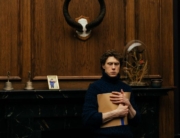With the recent conversations surrounding the merits and needs of the recent The Great Gatsby film, the adaptation of beloved classics still proves to be a current issue. Having been adapted into a myriad of movies since the medium’s creation, Shakespeare’s plays may be the most dissected topic in film translation. Joss Whedon’s foray into this realm is Much Ado About Nothing, for which he adapted the screenplay as well as directed. While the film doesn’t challenge the text or utilize the cinematic medium in any groundbreaking way, Much Ado is still an enjoyable traditional take on a classic play.
Whedon (The Avengers) takes a break from his usual sci-fi fare to focus on the romantic tale of Beatrice (Amy Acker) and Benedick (Alexis Denisof), two smart, funny, and obstinate characters who reject the idea of love. He moves his Much Ado into a modern setting, a gorgeous suburban mansion, where Don Pedro (Reed Diamond), a prince, has come to visit his friend Leonato (Clark Gregg), Beatrice’s uncle, after returning from war. Visually, the film depicts Don Pedro as a kind of political figure and Leonato as a wealthy socialite.
Don Pedro’s close companions, Benedick and Claudio (Fran Kranz), have traveled with him. Upon seeing Leonato’s daughter, Hero (Jillian Morgese), Claudio falls head over heels in love. The story follows the courtship of Claudio and Hero as well as everyone’s attempt to get Benedick and Beatrice to admit they love each other. In contrast to the romantic comedy, Don Pedro’s villainous brother Don John (Sean Maher) is hell-bent on ruining the happiness of his brother and his fellow companions. There is also a wonderful cameo from Nathan Fillion, who plays Dogberry, a hilariously inept chief of police.
Although Benedick and Beatrice are one of the most acerbic and quick-witted of Shakespeare’s couples, the true star of Much Ado may be the house in which most of the action takes place. Turns out it is actually owned by Whedon. Since most of the actors have appeared in other Whedon-related projects, the whole film feels like a bunch of friends have gotten together one weekend to perform some Shakespeare. The film moves quite briskly, and it’s clear everyone involved is having a good time so it’s hard not to join in on the fun. It’s also worth noting how much alcohol is consumed. It seems everyone has a glass in hand at all times.
The entire film is shot in black and white, giving it a classic Hollywood vibe. Visually, it’s difficult at points to connect the language with what’s happening. The rules of Shakespearean society don’t always translate to a modern setting seamlessly. There are a few moments where the juxtaposition is a bit much, especially with modern dressed characters in conversations about princes and 16th century morality.
It’s not rare to reset Shakespeare in contemporary times and keep the language intact, as in Michael Almereyda’s Hamlet, for instance, but it’s harder to imagine a better on-screen Benedick and Beatrice than Kenneth Branagh and Emma Thompson in the 1993 version of Much Ado. As much as I enjoyed Denisof and Acker, perhaps the translation as a whole doesn’t give them enough room to play with their characters. Still, the film is infectious, and there are some truly funny moments. While it’s maybe not wildly original or daring, it’s still lovely to see a sincere adaption.







Leave A Comment